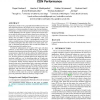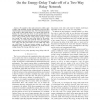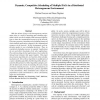74 search results - page 14 / 15 » Queues where customers of one queue act as servers of the ot... |
QUESTA
2008
13 years 5 months ago
2008
We consider a discrete-time tree network of polling servers where all packets are routed to the same node (called node 0), from which they leave the network. All packets have unit...
IMC
2009
ACM
14 years 17 days ago
2009
ACM
Replicating content across a geographically distributed set of servers and redirecting clients to the closest server in terms of latency has emerged as a common paradigm for impro...
CISS
2008
IEEE
14 years 15 days ago
2008
IEEE
—We consider a three node network in which a pair of nodes with stochastic arrivals communicate with each other with the help of an intermediate relay. The bi-directional nature ...
HCW
1998
IEEE
13 years 10 months ago
1998
IEEE
With the advent of large scale heterogeneous environments, there is a need for matching and scheduling algorithms which can allow multiple DAG-structured applications to share the...
MMB
2010
Springer
13 years 10 months ago
2010
Springer
Abstract. Computing tight performance bounds in feed-forward networks under general assumptions about arrival and server models has turned out to be a challenging problem. Recently...




